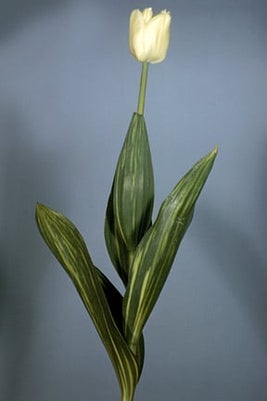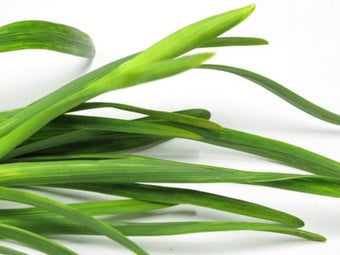
Quick facts
Common name - Tulip viruses
Scientific name - Various
Plants affected - Tulipa spp. (tulips)
Main symptoms - Streaked flowers, mottled leaves, distorted plant and stunted growth
Caused by - Viruses
Timing - Spring and early summer
What are tulip viruses?
There are at least 12 viruses that infect tulips, causing a range of symptoms, which are seen when the tulips have grown leaves in spring and early summer.
The six most important are:
- Tulip breaking virus (TBV)
- Arabis mosaic virus (ArMV)
- Tobacco rattle virus (TRV)
- Lily symptomless virus (LSV)
- Tobacco necrosis virus (TNV)
- Cucumber mosaic virus (CMV)
For more on how these viruses are transmitted, see the Biology section below.
Symptoms
You may see the following symptoms:
- ‘Breaks’ (streaks of a different colour) in the flowers (TBV)
- Brown, dead streaks appear in the leaves and stems (TNV)
- Mottled leaves (TRV, LSV)
- Sunken brown spots, arcs or rings in the ; such bulbs give rise to stunted and distorted plants (CMV)
- Plants may be stunted, but otherwise unaffected (ArMV, LSV)
Control
Non-chemical control
Very little can be done to control viruses in gardens, especially those that are vectored by soil-inhabiting organisms such as nematodes (eelworms) or Olpidium (a fungal root pathogen). The gardener’s best defence is to ensure that the come from a reputable source. Affected plants should be destroyed to prevent virus spreading to other tulips and other plants (some of the viruses discussed above have very wide host ranges among garden plants).
Chemical control
There are no chemical controls. The use of insecticides to reduce aphid transmission is not practical.
There are no soil sterilants available to home gardeners for control of nematodes or Olpidium.
Biology
Plant viruses are extremely minute infectious particles consisting of a protein coat and a core of nucleic acid. They have no means of self-dispersal, but rely on various vectors (including humans) to transmit them from infected to healthy plants. Once viruses penetrate into the plant cells they take over the cells’ nucleic acid and protein synthesis systems and ‘hijack’ them to produce more virus.
Viruses are frequently transmitted through propagated material but, depending on the virus, can also be transmitted via insect or mite vectors, pollen, mechanical transfer via contaminated hands and tools, and nematode vectors in the soil. Some viruses can be transmitted via seed, but generally these are a minority and therefore seed propagation is often a useful way to ensure virus-free plant material.
Viruses of tulips are vectored in a number of ways
- CMV, LSV and TBV are vectored by aphids
- ArMV and TRV are vectored by soil-inhabiting nematodes
- TNV is vectored by the microscopic fungal root pathogen Olpidium brassicae
Other viruses may be vectored by other insects, mites or by mechanical transmission on pruning tools and hands.
Tulip breaking virus (TBV) played an important role in 'tulipomania', which occurred in the Netherlands in the seventeenth century. The flower break patterns in affected were highly prized, and they commanded huge prices. Unfortunately, the effect was often not stable and affected bulbs did not repeat the patterns reliably in future years. The vigour of the virus-affected stock also frequently deteriorated over time. Tulip varieties with these patterns are available today, but the flower breaks result from stable mutation and not virus infection. The English florists' tulips are an exception, in which the breaks still result from infection with TBV and are remarkably stable, although these plants are seldom available for sale.





